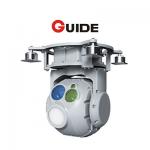GDES-200D05 EO IR Systems Airborne Observation Pod
|
Product Description:The GDES-200D05 airborne 2-axis multi sensors observation pod integrates high precision gyro stabilized platform, cooled MWIR infrared camera, high-definition visual camera and laser rangefinder. It is mainly designed for small helicopter, medium-sized rotor unmanned aerial vehicle (UAV) and can realize target detection, recognition and precise positioning through the high performance image sensor technology and high-precision stability control technology. The pod can also cooperate with the airborne system to complete auxiliary navigation, reconnaissance and surveillance, target positioning, geographic guidance and other tasks. Main Features:• High stability accuracy up to 0.05mrad Technical Parameters:
Support and Services:Our infrared detectors and thermal imaging modules are designed to provide high-quality thermal imaging solutions for a wide range of applications. We offer a range of technical support and services to help you get the most out of your product, including: · Product training and education Our team of experienced professionals is dedicated to providing you with the highest level of service and support possible. Contact us today to learn more about our product technical support and services. FAQs:Q: What is infrared thermal imaging technology? A: Infrared thermal imaging uses photoelectric technology to detect specific infrared band signals of thermal radiation from objects, converts these signals into images and graphics that can be visually distinguished by humans, and further calculates temperature values. Q: What is the wavelength range for infrared thermal imaging? A: Infrared ray, also known as infrared radiation, is an electromagnetic wave in the infrared wavelength range between visible light and microwave. Thermal infrared imaging typically refers to mid infrared imaging at 3-5μm and far-infrared imaging at 8-12μm. In these bands, the focus is on heat sources, not visible light. The human eye is sensitive to the wavelength range of about 0.4~0.7μm and cannot see longer wavelengths of thermal energy. Q: What is the classification of infrared thermal imaging wavebands? A: Generally speaking, infrared thermal imaging is divided into
three bands: short wave, medium wave, and long wave. Q: What are the applications of infrared detectors and thermal imaging modules? A: The infrared detectors and thermal imaging modules can be used in a variety of applications such as thermography, security & surveillance, intelligent industry, outdoor night vision observation, machine vision, smart driving, UAVs, and consumer infrared products. Q: Does infrared thermal imaging emit radiation? A: Infrared thermal imaging passively receives infrared signals emitted by objects and does not have radiation. As long as an object exceeds absolute zero, an infrared signal will be emitted, which is received by an infrared detector and then converted into a thermal image. |
||||||||||||||||||||||||||||||||||||||||||||||||||||||
| Product Tags: Multi Sensors Observation Pod Airborne Observation Pod EOIR Systems Observation Pod | ||||||||||||||||||||||||||||||||||||||||||||||||||||||


